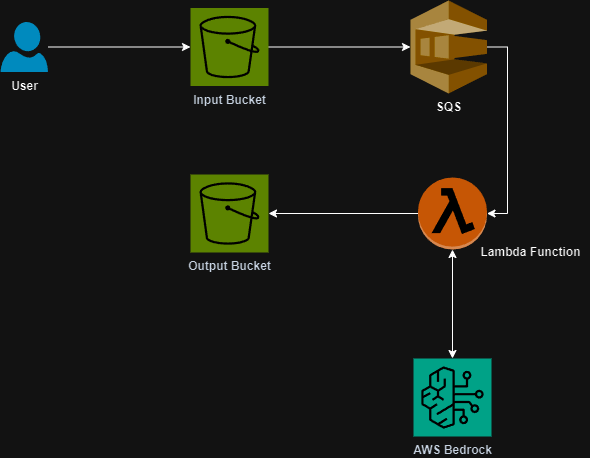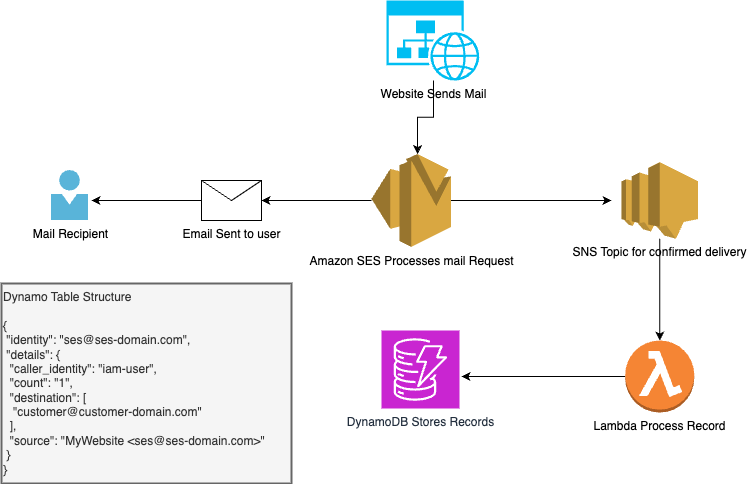I have a PowerPoint party to go to soon. Yes you read that right. At this party everyone is required to present a short presentation about any topic they want. Last year I made a really cute presentation about a day in the life of my dog.
This year I have decided that I want to bore everyone to death and talk about technology, Python, Terraform and Artificial Intelligence. Specifically, I built an application that allows a user to upload an image and have it return to them a renamed file that is labeled based on the object or scene in the image.
The architecture is fairly simple. We have a user connecting to a load balancer which routes traffic to our containers. The containers connect Bedrock and S3 for image.

If you want to try it out the site is hosted at https://image-labeler.vansledright.com It will be up for some time, I haven’t decided how long I will host it for but at least through this weekend!
Here is the code that interacts with Bedrock and S3 to process the image:
def process_image():
if not request.is_json:
return jsonify({'error': 'Content-Type must be application/json'}), 400
data = request.json
file_key = data.get('fileKey')
if not file_key:
return jsonify({'error': 'fileKey is required'}), 400
try:
# Get the image from S3
response = s3.get_object(Bucket=app.config['S3_BUCKET_NAME'], Key=file_key)
image_data = response['Body'].read()
# Check if image is larger than 5MB
if len(image_data) > 5 * 1024 * 1024:
logger.info("File size to large. Compressing image")
image_data = compress_image(image_data)
# Convert image to base64
base64_image = base64.b64encode(image_data).decode('utf-8')
# Prepare prompt for Claude
prompt = """Please analyze the image and identify the main object or subject.
Respond with just the object name in lowercase, hyphenated format. For example: 'coca-cola-can' or 'golden-retriever'."""
# Call Bedrock with Claude
response = bedrock.invoke_model(
modelId='anthropic.claude-3-sonnet-20240229-v1:0',
body=json.dumps({
"anthropic_version": "bedrock-2023-05-31",
"max_tokens": 100,
"messages": [
{
"role": "user",
"content": [
{
"type": "text",
"text": prompt
},
{
"type": "image",
"source": {
"type": "base64",
"media_type": response['ContentType'],
"data": base64_image
}
}
]
}
]
})
)
response_body = json.loads(response['body'].read())
object_name = response_body['content'][0]['text'].strip()
logging.info(f"Object found is: {object_name}")
if not object_name:
return jsonify({'error': 'Could not identify object in image'}), 422
# Get file extension and create new filename
_, ext = os.path.splitext(unquote(file_key))
new_file_name = f"{object_name}{ext}"
new_file_key = f'processed/{new_file_name}'
# Copy object to new location
s3.copy_object(
Bucket=app.config['S3_BUCKET_NAME'],
CopySource={'Bucket': app.config['S3_BUCKET_NAME'], 'Key': file_key},
Key=new_file_key
)
# Generate download URL
download_url = s3.generate_presigned_url(
'get_object',
Params={
'Bucket': app.config['S3_BUCKET_NAME'],
'Key': new_file_key
},
ExpiresIn=3600
)
return jsonify({
'downloadUrl': download_url,
'newFileName': new_file_name
})
except json.JSONDecodeError as e:
logger.error(f"Error decoding Bedrock response: {str(e)}")
return jsonify({'error': 'Invalid response from AI service'}), 500
except Exception as e:
logger.error(f"Error processing image: {str(e)}")
return jsonify({'error': 'Error processing image'}), 500If you think this project is interesting, feel free to share it with your friends or message me if you want all of the code!




